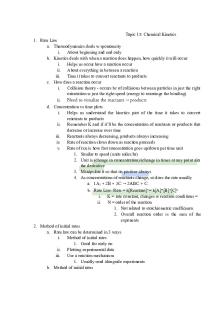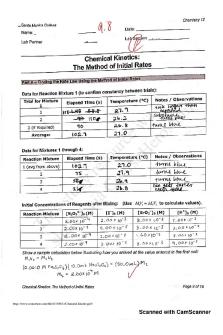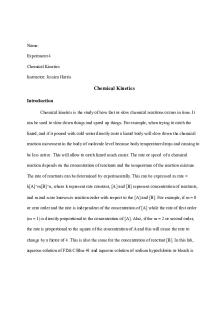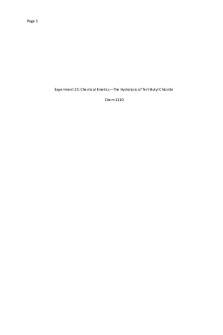The Rate Law in Chemical Kinetics PDF

| Title | The Rate Law in Chemical Kinetics |
|---|---|
| Course | Chemistry of Solutions |
| Institution | Dawson College |
| Pages | 7 |
| File Size | 150.5 KB |
| File Type | |
| Total Downloads | 397 |
| Total Views | 541 |
Summary
The Rate Law in Chemical KineticsI. IntroductionThe rate of a reaction is the change in concentration of a reactant or a product per unit of time. The goal of this experiment was to determine the rate law, which only takes into account the reactants, and the constant k of the following reaction:2 I(...
Description
The Rate Law in Chemical Kinetics Experiments #8
Lab section: 20 202-NYB-05
Date the experiment was performed: Thursday, April 12 th 2018 Date of lab report submission: Thursday, April 19 th, 2018
I. Introduction The rate of a reaction is the change in concentration of a reactant or a product per unit of time. The goal of this experiment was to determine the rate law, which only takes into account the reactants, and the constant k of the following reaction: (aq) (aq) 2−¿ 2 SO ¿ 2−¿ O ¿ I 2(aq)+¿ −¿+S 2 ¿ ¿ 2 I (aq) 2−¿ n −¿ ] Rate = k [ I ¿ ]m[ S 2 O¿8 It is not possible to determine the rate law of this reaction without doing an experiment. In 2−¿ this lab, the method of initial rates was used. By maintaining the concentration of S 2 O 8¿ −¿ constant for the first five runs, the order of the reaction (m) with respect to I ¿ was found. −¿ ¿ remained constant and the concentration For the last four runs, the concentration of I 2−¿ ¿ of changed. S 2 O8 If starch is added only to the previous reaction, the color change would happen too fast. Therefore, a second reaction, which occurred at the same time as the other one, was used: (aq) (aq) 2−¿ S 4 O¿ −¿+¿ 2−¿ ¿ O ¿ I 2(aq) → 2 I (aq) 2 S2 ¿ In this reaction,
2−¿ S 2 O¿3
used up the I 2
; thus, delaying the apparition of the deep blue
2−¿ was consumed, the mixture turned blue. Since its initial S 2 O¿3 concentration could be calculated from the values already known, it was possible to determine color. When all of the
the initial rate of the reaction with the following formula: 2−¿ S2 O¿3 ¿ ∆¿ −1 R0 = ∙¿ 2
¿ ∆ t=time taken for the mixture ¿ change ¿
II. Procedure Refer to the Laboratory Manual.
III. Data and Results Table 1: Reagent Concentrations Reagent
Concentration (mol/L)
KI
0.180
Na 2 S2 O 3
0.0036
(NH 4 )2 S 2 O 8
0.180
Table 2: Time taken for each run Run
Time (s)
1
26.54
2
30.28
3
36.66
4
44.45
5
60.93
6
28.62
7
33.44
8
40.05
9
67.89
Table 3: Initial Concentrations −¿ ¿ I ¿ (mol/L) ¿ ¿
Run
1
0.0720
−¿ ¿ I Ln ¿ ¿ ¿
2−¿ S 2 O¿8 (mol/L) ¿ ¿ ¿
2−¿ S 2 O¿8 Ln ¿ ¿ ¿
-2.631
0.0720
-2.631
2
0.0600
-2.813
0.0720
-2.631
3
0.0480
-3.037
0.0720
-2.631
4
0.0360
-3.324
0.0720
-2.631
5
0.0240
-3.730
0.0720
-2.631
6
0.0720
-2.631
0.0600
-2.813
7
0.0720
-2.631
0.0480
-3.037
8
0.0720
-2.631
0.0360
-3.324
9
0.0720
-2.631
0.0240
-3.730
Table 4: The Initial Rates and the k Run
R0
Ln R0
k ( L/mol ∙ s )
1
0.000014
-11.21
0.0026
2
0.000012
-11.34
0.0028
3
0.0000098
-11.53
0.0028
4
0.0000081
-11.72
0.0031
5
0.0000059
-12.04
0.0034
6
0.000013
-11.28
0.0029
7
0.000011
-11.44
0.0031
8
0.0000090
-11.62
0.0035
9
0.0000053
-12.15
Table 5: Temperature and Average K Temperature (K)
295.5
Average K (mol/L ∙ s)
0.0030
IV. Sample Calculations Run 1 1) Number of moles of M=
2−¿ S 2 O 3¿
n V
n 0.0150 n=0.000054 mol
0.0036=
2) Concentration of M=
n V
2−¿ ¿ S 2 O3
0.0031
0.000054 0.0750 M =0.00072 mol / L M=
3) Concentration of
2−¿ reacted S 2 O¿8
2−¿ S2 O8¿ ¿ S ¿ 2−¿ ¿ 2O¿3 ¿ ¿ ¿ 2−¿ S 2 O¿8 ¿ ¿ 2−¿ ¿ S 2 O8 ¿ ¿ 4) Initial reaction rate 2−¿ ¿ S2 O 3 ¿ ∆¿ 1 R0 = ∙ ¿ 2 1 0.00072 R0 = ∙ 2 26.54 R0=0.000014 mol/ L ∙ s
5) Initial concentration of
−¿¿ I
M 1 ∙ V 1=M 2 ∙ V 2 0.180 ∙30.0 =M 2 ∙ 75.0 M 2=0.0720 mol / L 6) Initial concentration of
2−¿ ¿ S 2 O8
M 1 ∙ V 1=M 2 ∙ V 2 0.180 ∙30.0 =M 2 ∙ 75.0 M 2=0.0720 mol / L 7) k value 2−¿ 1 −¿ ¿ ] Rate = k [ I ¿ ]1[ S 2 O8 0.000014 =k ∙ 0.0720 ∙ 0.0720 k =0.0026 L/mol ∙ s
8) Average k average k=
0.0026 + 0.0028+ 0.0028 + 0.0031 + 0.0034 + 0.0029 + 0.0031 + 0.0035 + 0.0031 9
average k=0.0030 L/mol ∙ s
V. Conclusion The objective of this experiment was to determine the rate law and the constant of the following reaction: ( aq) ( aq) 2 SO2−¿ ¿ O 2−¿ I ¿ 2(aq)+ ¿ −¿+ S 2 ¿ ¿ 2 I (aq)
2−¿ −¿ It was achieved since the rate law and its constant were: Rate = k [ I ¿ ]1[ S O ¿ ]1. The 2 8 orders were found by taking the slope of the graphs. For this lab, there were some sources of error. For example, when the solution of flask 2 was poured into flask 1, it is likely that not all of the 30 mL got in the first flask, since spilling occurred. Therefore, next time, a beaker should be used instead of flask 1. Since the beaker has a larger opening, it is less probable for spilling to occur. In addition, there was always a delay between the moment the solution turned dark blue and the reaction time to record the time. This delay added more seconds to the times recorded....
Similar Free PDFs

Topic 15 Chemical Kinetics
- 5 Pages

Chemical Kinetics lab
- 9 Pages

Chapter 14- Chemical Kinetics
- 3 Pages

Chemical Kinetics-DR. ASM
- 44 Pages

Chemical Kinetics - lab report
- 4 Pages

Lab 11 Chemical Kinetics Report
- 4 Pages

Chemical Kinetics - Lecture notes 1
- 23 Pages

Experiment 24-Rate Law
- 11 Pages

Rate Law Worksheet Answers
- 2 Pages
Popular Institutions
- Tinajero National High School - Annex
- Politeknik Caltex Riau
- Yokohama City University
- SGT University
- University of Al-Qadisiyah
- Divine Word College of Vigan
- Techniek College Rotterdam
- Universidade de Santiago
- Universiti Teknologi MARA Cawangan Johor Kampus Pasir Gudang
- Poltekkes Kemenkes Yogyakarta
- Baguio City National High School
- Colegio san marcos
- preparatoria uno
- Centro de Bachillerato Tecnológico Industrial y de Servicios No. 107
- Dalian Maritime University
- Quang Trung Secondary School
- Colegio Tecnológico en Informática
- Corporación Regional de Educación Superior
- Grupo CEDVA
- Dar Al Uloom University
- Centro de Estudios Preuniversitarios de la Universidad Nacional de Ingeniería
- 上智大学
- Aakash International School, Nuna Majara
- San Felipe Neri Catholic School
- Kang Chiao International School - New Taipei City
- Misamis Occidental National High School
- Institución Educativa Escuela Normal Juan Ladrilleros
- Kolehiyo ng Pantukan
- Batanes State College
- Instituto Continental
- Sekolah Menengah Kejuruan Kesehatan Kaltara (Tarakan)
- Colegio de La Inmaculada Concepcion - Cebu






